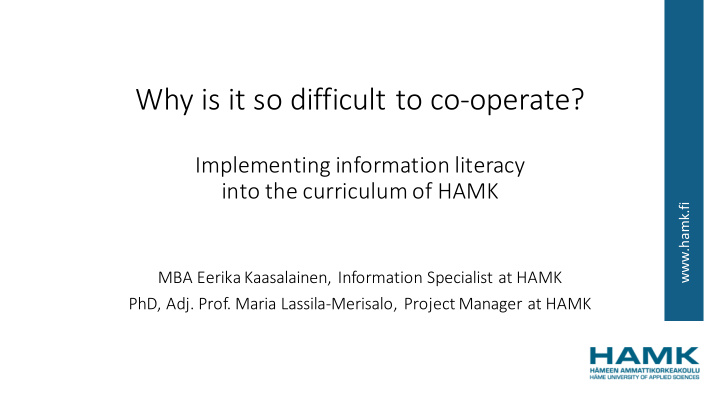



Why is it so difficult to co-operate? Implementing information literacy into the curriculum of HAMK www.hamk.fi MBA Eerika Kaasalainen, Information Specialist at HAMK PhD, Adj. Prof. Maria Lassila-Merisalo, Project Manager at HAMK
The educational system in Finland Finland’s system of higher education is based on a dual model, where more academically oriented traditional universities (14) and more practically www.hamk.fi oriented universities of applied sciences (24) complement each other. Both award legally equivalent academic Bachelor’s and Master’s degrees.
Häme University of Applied Sciences HAMK Häme University of Applied Sciences HAMK consists of 17 individual learning institutions, which have been melted into one HAMK. HAMK operates on seven campuses within a 100 kilometer radius in southern Finland. The individual campuses have long histories and strong www.hamk.fi traditions; e.g. Mustiala was founded in 1840 as Agricultural Institute. HAMK has 600 staff members and 7000 students. Each HAMK campus has its own library.
IL at HAMK • Before: IL education was unsystematic and inconsistent. • Currently: A development project startedin December 2015, including following actions: • the education in IL is being systemized, www.hamk.fi • a summer course combining information literacyskills and essaywriting is underway, and • a learning badge in IL for the staff is underway. • In the future: • All HAMK students get equal education in IL, starting from fall 2016. • 75% of the staff gets a learning badge by the end of 2017.
Guidelines IL CONTEXT • Framework for information literacy for higher education (ACRL 2016) • Recommendations for the higher education sector (EMPATIC 2012) • National recommendations for information literacy in higher education (Council for Finnish University Libraries & The AMKIT Consortium 2013) www.hamk.fi EDUCATIONAL CONTEXT • Objectives for degrees in the universities of applied sciences (Ministry of Education and Culture) • Objectives for degrees (HAMK)
Implementation (1) - IL education for students • Phase 1: all first-year students get familiar with HAMK library services either during a guided library visit or an independent course in Moodle learning environment. • Ph Phase 2: all seco cond-ye year students learn the basics of information literacy y ski kills. Th This entity y will be guided by y an information specialist, a communication teacher, www.hamk.fi an and a a subject teac acher, an and the as assig ignments will ill be tig ightly ly in integrat ated wit ith the su subject. • Phase 3: students about to start their thesis get guidance in information skills.
Implementation (2) - summer course • Pilot project: a summer course combining information literacy and essay writing, optional for all students www.hamk.fi
Implementation (3) - Learning badges for staff • Badges weretaken in use at HAMK as a tool for HRD in 2016, badges for students will be introduced later • Mozilla Open Badge Factory • Library’s own meta badge will be taken in use in autumn 2016 www.hamk.fi • Meta badge consists of eight sub badges, which include following topics: • Effective use of library services and databases, source criticism, open access and predator publishers, open science, source referencing, self-reflection
Challenges • Change resistance (big changes both nationally and at HAMK: funding, collaborative teaching, new education models etc.) • Status: information specialists are not a valid part of the teaching process (Saunders 2012; Lahtinen 2014.) • Co-operation between autonomous professionals (Mäki 2012.) www.hamk.fi • Coordination (autonomy of the schools, responsibility issues) • Justification (certain practically oriented fields don’t see the relevance)
Possibilities • The staff is oriented to change in general • The new module structure • easier to integrate new content into the curriculum • a chance to create new open-minded entities www.hamk.fi • Collaborative teaching (subject teachers learn from information specialists and vice versa)
Conclusions • No concreteresults at this point, as we are only starting. • Module structurehas already given encouraging examples. • In the beginning it is importantto find key people to start the co- operation with. www.hamk.fi • After that the big challenge is to get systematization and continuity. • We will be happy to update you with concreteresults of how we succeeded.
Thank you! www.hamk.fi eerika.kaasalainen@hamk.fi maria.lassila-merisalo@hamk.fi
REFERENCES: • ACRL. (2015). Framework for InformationLiteracy for Higher Education. Available http://www.ala.org/acrl/standards/ilframework • Council for Finnish University Libraries & The AMKIT Consortioum. (2013). National recommendations for information literacy in higher education. • EMPATIC. (2012). Recommendations for the Higher Education Sector. Information Literacy in the higher Education learning sector (HE) – recommendations to policy makers (the Erasmus programme area). Available: http://empatic.ceris.cnr.it/eng/Findings- Recommendations/Higher-Education-Recommendations • Lahtinen, J. (2014). Jaetun opettajuuden haasteet: kirjaston, opetuksen ja työelämän yhteistyö hoitoalan koulutuksen hankkeessa. Informaatiotutkimus. Vol.33, nro 4. www.hamk.fi • Mäki, K. 2012. Opetustyön ammattilaiset ja mosaiikin mestarit. Työkulttuurit ammattikorkeakouluopettajan toiminnan kontekstina. Jyväskylä Studiesin Business and Economics 109. Jyväskylän yliopisto. • Saunders. (2012). Faculty Perspectives on InformationLiteracy as a StudentLearning Outcome. The Journal of Academic Librarianship , Volume 38, Issue 4, Pages226-236 • SYN & AMKIT, (2013). Suositus Suomen korkeakouluille. Informaatiolukutaito korkeakouluopinnoissa. Available: http://yliopistokirjastot.fi/wp-content/uploads/2015/06/ILsuositus_FI.pdf
Recommend
More recommend